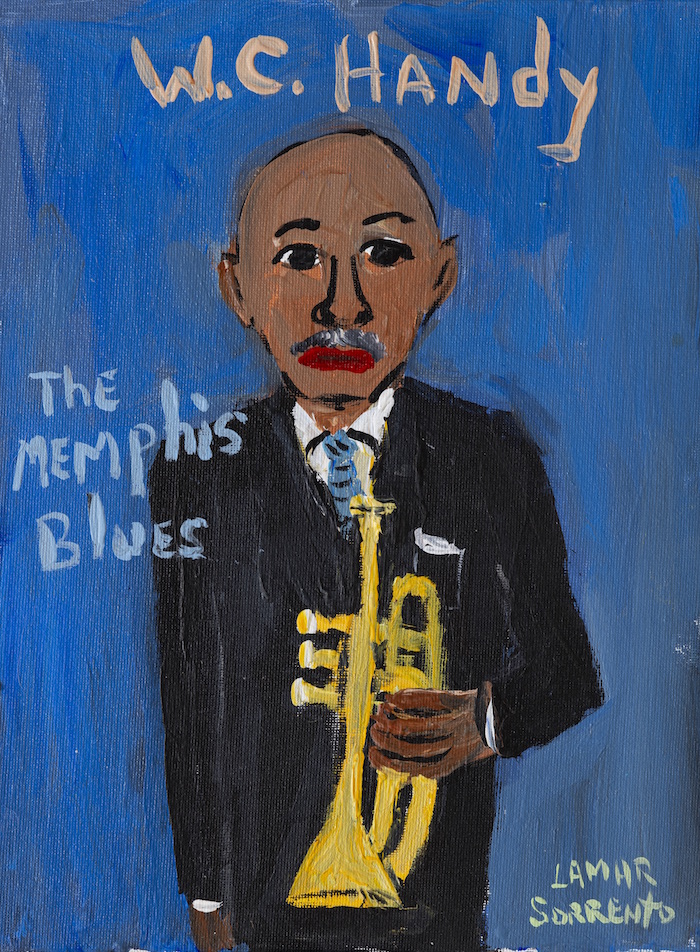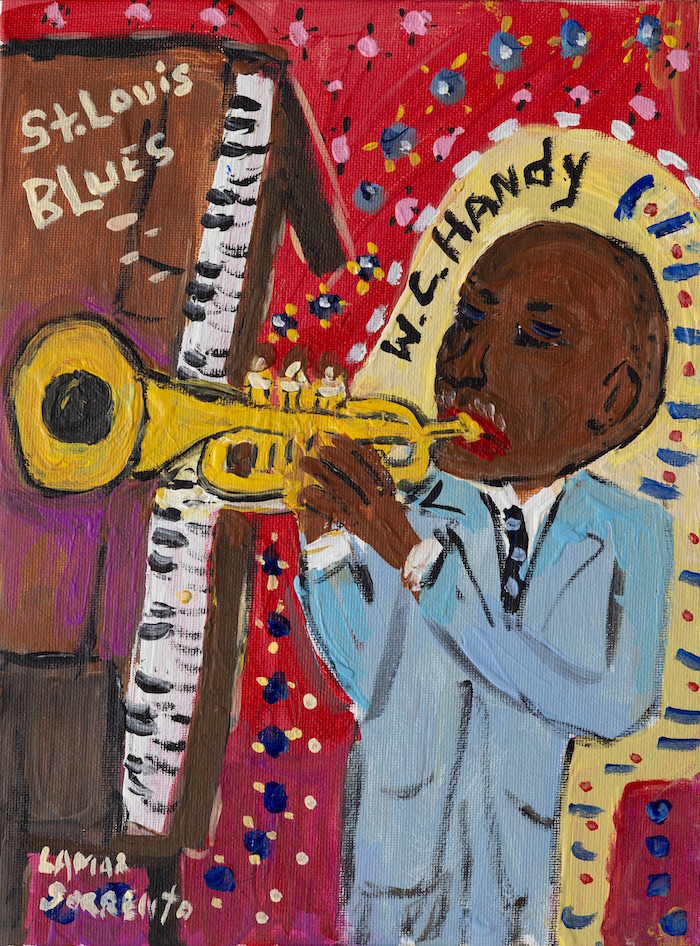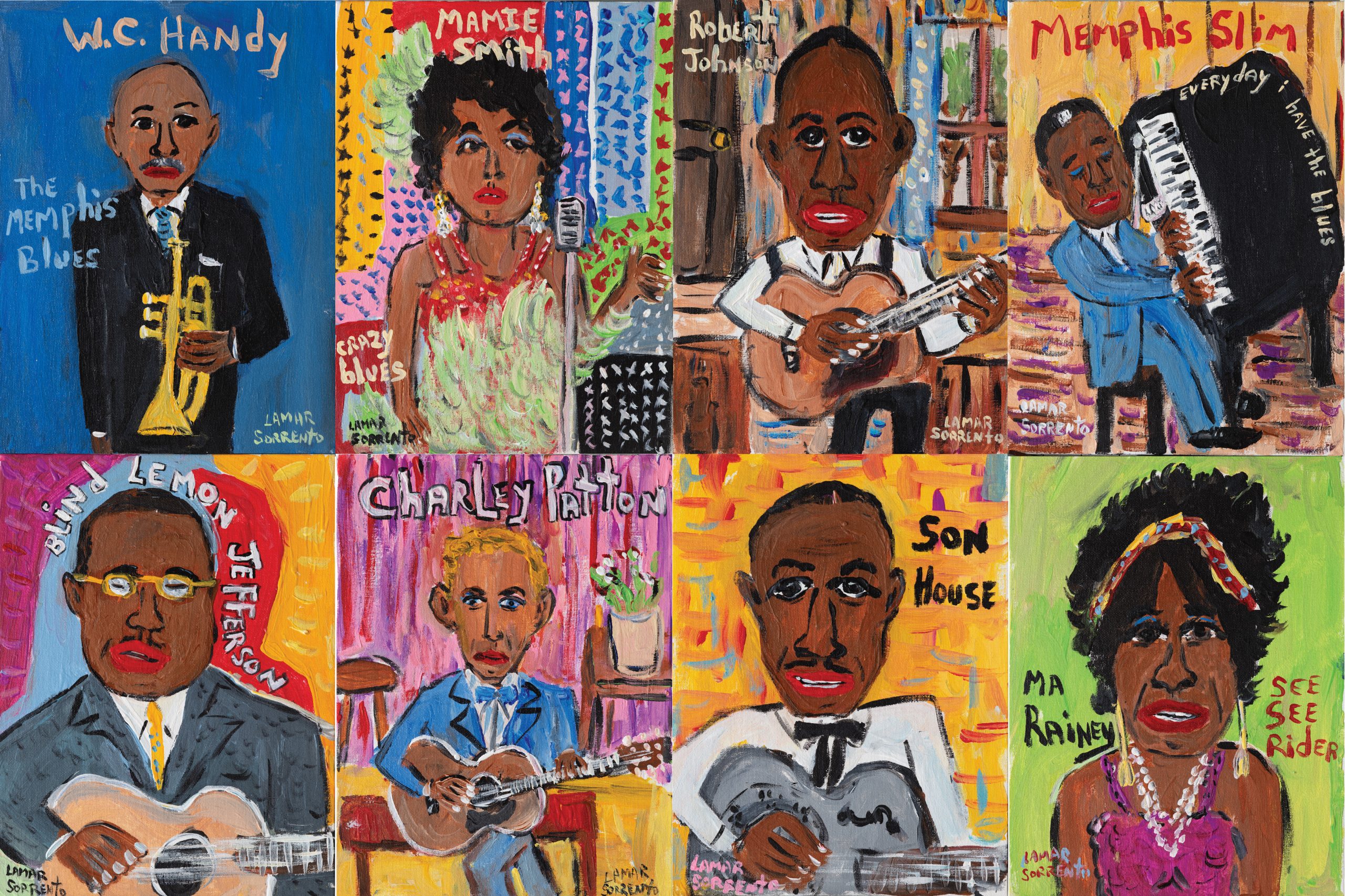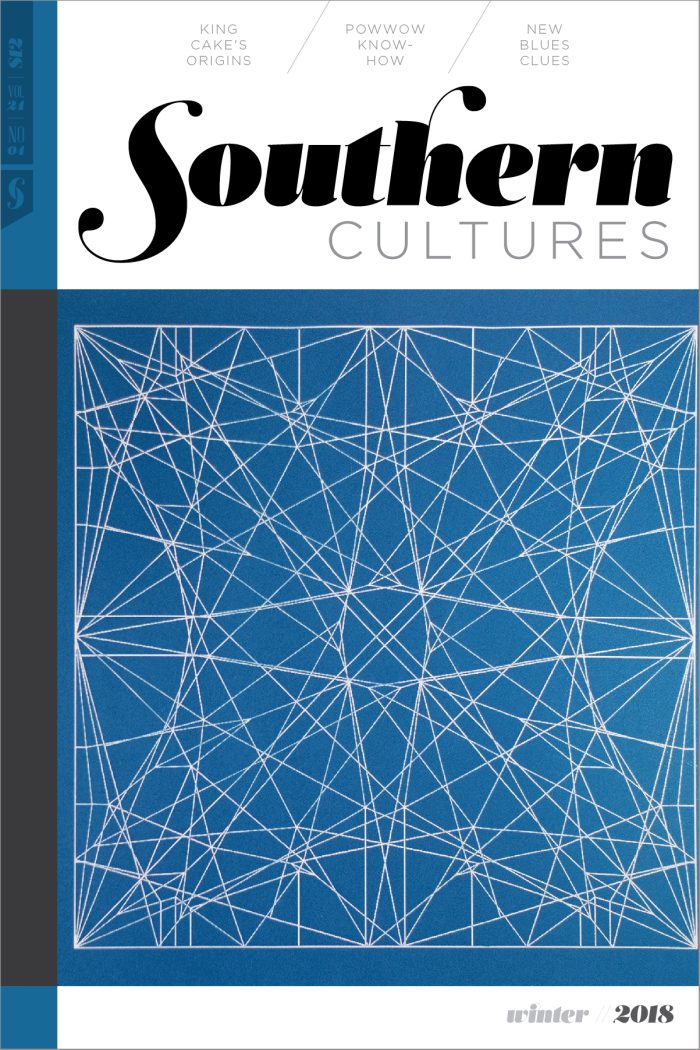This article has been condensed from a longer essay that first appeared in the Winter 2018 Issue. Access the entire essay via Project Muse (link below).
It was W. C. Handy, as much as anybody, who was responsible for gifting us with the mythology of Mississippi as ground zero for the blues. Virtually every blues history quotes or describes one or both of the key blues discovery moments in Handy’s 1941 autobiography Father of the Blues, even as those histories frame the author himself as a less-than-bluesy figure: not a bluesman, but a bandleader and songwriter who heard, adapted, published, used the blues, then wrote a life narrative featuring himself at the center of the blues origins-and-emergence story. This portrait of Handy isn’t untrue, yet it lacks the sort of nuance that might enable us to distinguish Handy’s real achievement from the hype and criticism.
Handy entered the world of professional black entertainment in the late 1890s as a cornetist and bandleader for Mahara’s Minstrels, a touring company run by an Irishman named Frank Mahara. “It goes without saying,” Handy wrote in Father of the Blues, “that [black] minstrels were a disreputable lot in the eyes of a large section of upper-crust Negroes . . . but it was also true that all the best talent of that generation came down the same drain.” True to his bourgeois heritage, Handy reconstructed a déclassé vernacular entertainment as an instrument of uplift, a cradle in which self-respect and creative self-realization are enabled by a brotherhood of ambitious young black men.1
But, crucially, Handy also makes clear that the Jim Crow world these young men traversed was a kind of killing field in which the protocols of white supremacy had to be navigated on a daily basis. In a Texas town, white kids pelt Handy’s band and their instruments with stones (43–44). Handy’s own hot temper gets him in trouble one night in Tennessee when he punches a misbehaving white man in the mouth; he escapes lynching only by hiding in a beneath-the-floorboards compartment in the minstrels’ Pullman coach (46–47).
The evocation of black minstrelsy in Father of the Blues shows us a violent and racist pre-blues world in which Handy and his peers had the blues, simultaneously mourning, bridling at, and laughing off their own subjugation, even as they sought to express themselves through an aging vernacular art form that was utterly unfit for the task. One key transformation that he and the race records revolution helped engender was a shift from the mocking laughter of minstrelsy to the bittersweet sadness of the blues. He also helped install and celebrate two new and potent archetypes of blackness: the blues “queen” and the rambling, guitar-toting “musicianer,” both of whom he configures as powerful conveyors of race-wide grief. His one indelible composition, “St. Louis Blues” (1914), may be the most famous blues song in the world, and it is surely one of the most widely recorded.2

Handy dreamed up “St. Louis Blues,” he tells us, in one long night in a Beale Street rooming house, a beachhead he established as a creative retreat from the distractions of domestic life. “My first decision,” he says, “was that my new song would be another blues, true to the soil and in the tradition of Memphis Blues. Ragtime, I had decided, was passing out” (118). The ragtime he has in mind isn’t the orchestral art of Scott Joplin but the catchy, light-hearted backing for so-called “coon songs,” a heightened form of minstrelsy featuring boastful, razor-wielding, watermelon-eating black roughnecks. Handy knows all about such stuff and decides that his song “would have an important difference” from such retrograde material: “The emotions that it expressed were going to be real” (119).
The emotional core of “St. Louis Blues” is generated by a moment of profound empathy with a female resident of that city who serves Handy as a folk exemplar, a native informant proffering the deepest of blues laments. A “flood of memories” places the Beale-Street-ensconced Handy back in St. Louis during his youthful wanderings—“broke, unshaven, wanting even a decent meal, and standing before the lighted saloon . . . without a shirt under my frayed coat”—and reminds him of “a woman whose pain seemed even greater than his own” as she muttered, “Ma man’s got a heart like a rock cast in de sea” (119) and stumbled past him, drunk and grief- stricken. The blues, his blues, he resolves, will honor, rather than mock, that emotional pain.
Of all the elements in Handy’s synthesis, the most significant in the long run—and the key to “St. Louis Blues”’s success—is his brilliantly simple solution to the blues songwriter’s quandary: how to render the microtonal subtleties of blues singing on the page, as sheet music. “The primitive Southern Negro,” he begins, “as he sang was sure to bear down on the third and seventh tones of the scale, slurring between major and minor. . . . I had tried to convey this effect in Memphis Blues by introducing flat thirds and sevenths (now called “blue notes”) into my song, although its prevailing key was the major; and I carried this device into my new melody as well” (120). The magic inheres in the tension between the major “prevailing key” and specific minor-y pitches that good blues singers know how to hit as they move melismatically upward and downward through what we have learned in subsequent years to call the blues scale. Those minor-y pitches don’t exist in standard western musical notation. They’re in-between notes. More often than not, these pitches move subtly upward or downward in the brief interval after they’re sounded.
Handy knew that it was impossible to accurately represent this sort of pitch-bending magic on the printed page, but he also knew how to approximate the magic, however roughly. It was possible to insert minor thirds and sevenths into a major key song. It was possible to use a minor third and major third in sequence in a song’s melody. The opening “I” in the first published version of “St. Louis Blues”—“I hate to see the evenin’ sun go down”—is sung to precisely that slurred sequence of notes. (The minor-third-in-a-major-key trick was, in his own time, actually called Handy’s “World Famous Blue Note.”)3
Father of the Blues isn’t just a songwriter’s spirited self-defense; it’s also the invaluable testimony of a witness to the earliest days of the Mississippi blues. And here we come at last to the pair of passages for which Handy is justly famous, though they are also routinely misunderstood. One night, while dozing at a train station in Tutwiler, a small Delta town, he is “wakened . . . with a start” by a strange and captivating music:
A lean, loose-jointed Negro had commenced plunking a guitar beside me while I slept. His clothes were rags; his feet peeped out of his shoes. His face had on it some of the sadness of the ages. As he played, he pressed a knife on the strings of the guitar in a manner popularized by Hawaiian guitarists who used steel bars. The effect was unforgettable. His song, too, struck me instantly. “Goin’ where the Southern cross’ the Dog . . .” The singer repeated the line three times, accompanying himself on the guitar with the weirdest music I had ever heard (74).
As cultural historian Bryan Wagner has argued, the origin story Handy offers here “helped to sanctify the train-hopping threadbare drifter as a central character in the iconography of the black tradition.” But by transforming the singer’s imputed inner grief into an enduring racial legacy, “the sadness of the ages” revealed on his face, Handy turns away from the specifics of contemporary social history to create a legend. For, “the one thing we can know for sure about Handy’s songster,” Wagner argues brilliantly, “is that he is legally vulnerable.” He was a vagrant, in the state’s eyes—a social undesirable targeted by new laws that Deep South jurisdictions were enacting to control the movement of black men no longer formally imprisoned by slavery.4
The Tutwiler guitarist and blues singer becomes Handy’s crossroad guide: he’s a guardian of the threshold across which the ambitious young composer must pass. He’s double-voiced, a skilled signifier who schools the educated but clueless Handy in local language use. What Handy needs to overcome, he admits a page or two later, is the prejudice engendered by his own musical training: “As a director of many respectable, conventional bands, it was not easy for me to concede that a simple slow-drag and repeat could be rhythm itself. Neither was I ready to believe that this was just what the public wanted. But we live to learn” (76).

His enlightenment soon comes in another Mississippi town on a similarly memorable night. He is in Cleveland, twenty-five miles southwest of Tutwiler, leading his orchestra through a dance program, when someone sends up a note asking if he and the band would play some of their “native music” (76). Handy tries to meet this curious request, but the men in his orchestra sit at the high end of the black musical totem pole—they’re full-time sight-readers who “bowed strictly to the authority of printed notes” (76)— and the “sophisticated” (76) melody they come up with leaves the crowd unmoved. So a second request is made: Would Handy’s band take a break and give a “local colored band” (76) a chance to play a few dance songs?
The music they made was pretty well in keeping with their looks. They struck up one of those over-and-over strains that seem to have no very clear beginning and certainly no ending at all. The strumming attained a kind of disturbing monotony, but on and on it went, a kind of stuff that has long been associated with cane rows and levee camps. Thump-thump-thump went their feet on the floor. Their eyes rolled. Their shoulders swayed. And through it all that little agonizing strain persisted. (76–77).
What they seem to have been is conversant with the blues—homegrown analogues and precursors to Handy and his band, ambitious young musicians who had figured out something that Handy was just about to figure out: blues was the new sound, and it sold: “There before the boys lay more money than my nine musicians were being paid for the entire engagement. Then I saw the beauty of primitive music. They had the stuff the people wanted. . . My idea of what constitutes music was changed by the sight of that silver money cascading around the splay feet of a Mississippi string band” (77).
There is a long foreground, in other words, for the emergence of a mass white blues audience that began with the folk revival of the late 1950s and caught fire with the British blues invasion of the mid-1960s. Handy is a part of all this. He felt the power of the music, surging up from down below; he translated the complexities of blues singing into the profitable abstraction known as the blue note; and he crafted a myth through which premodern Mississippi becomes the scene of transmission as threadbare black musicians open his eyes, schooling him in what he needs to know. As a witness to history, he’s left us with an invaluable first-person account—as complicated, paradoxical, and suggestive, in its own way, as the music he sought to appropriate, champion, and memorialize.
This essay first appeared in the Winter 2018 issue (vol. 24, no. 4). Read the essay in its entirety, featuring additional blues musicians, via Project Muse.
Adam Gussow is a professor of English and southern studies at the University of Mississippi and a blues harmonica player and teacher. He has published a number of books on the blues, including Mister Satan’s Apprentice: A Blues Memoir (1998), Seems Like Murder Here: Southern Violence and the Blues Tradition (2002), and Beyond the Crossroads: The Devil and the Blues Tradition (2017), which the readers of Living Blues selected as “Best Blues Book of 2017.” He has just completed a new book, Blues Talk, an introduction to blues music, literature, culture, and scholarship that highlights racial problematics within the contemporary blues scene.

- W. C. Handy, Father of the Blues: An Autobiography (1941; New York: Da Capo, 1991), 33. All future references to Father of the Blues are included parenthetically in the text.
- For more on “an aging vernacular art form”: I write at length about this idea in Seems Like Murder Here: Southern Violence and the Blues Tradition (Chicago: University of Chicago Press, 2002), 81–93.
- David Robertson, W. C. Handy: The Life and Times of the Man Who Made the Blues (Tuscaloosa: University of Alabama Press, 2011), 97.
- Bryan Wagner, Disturbing the Peace: Black Culture and the Police Power after Slavery (Cambridge, MA: Harvard University Press, 2009), 27, 37.


